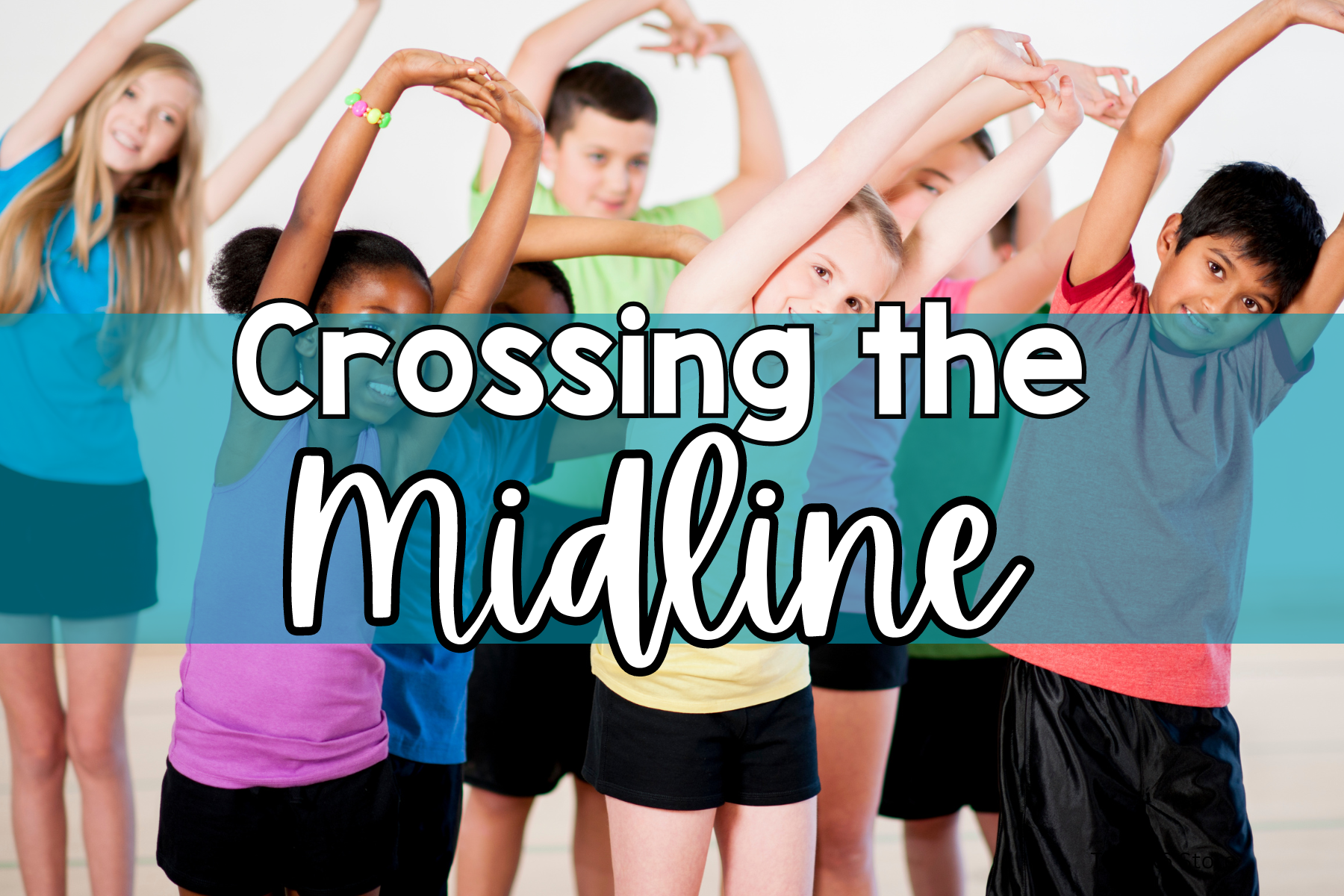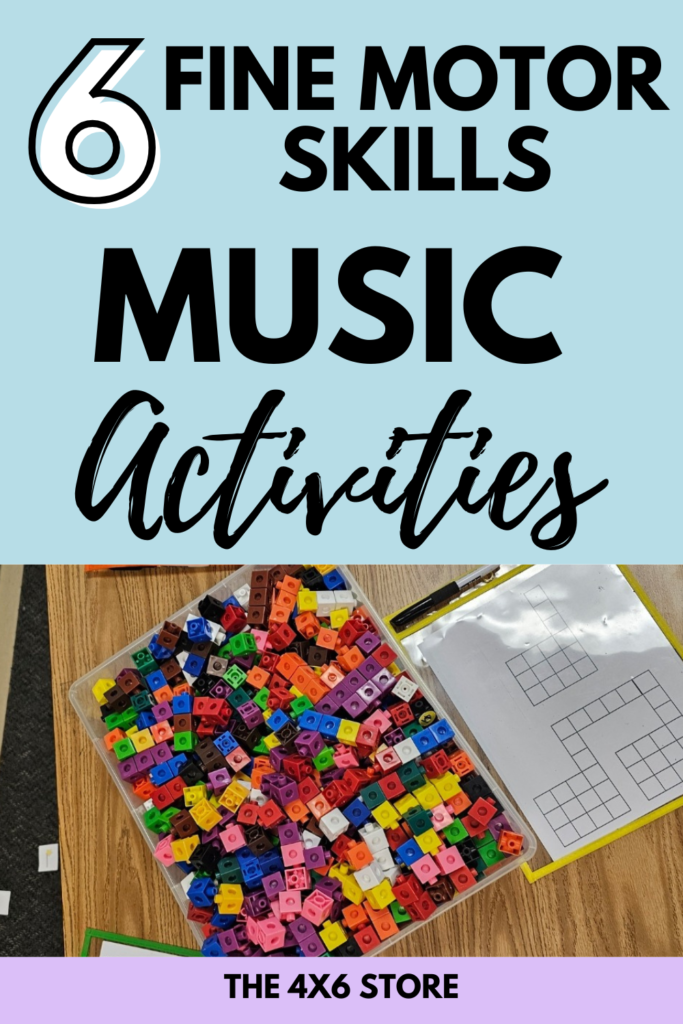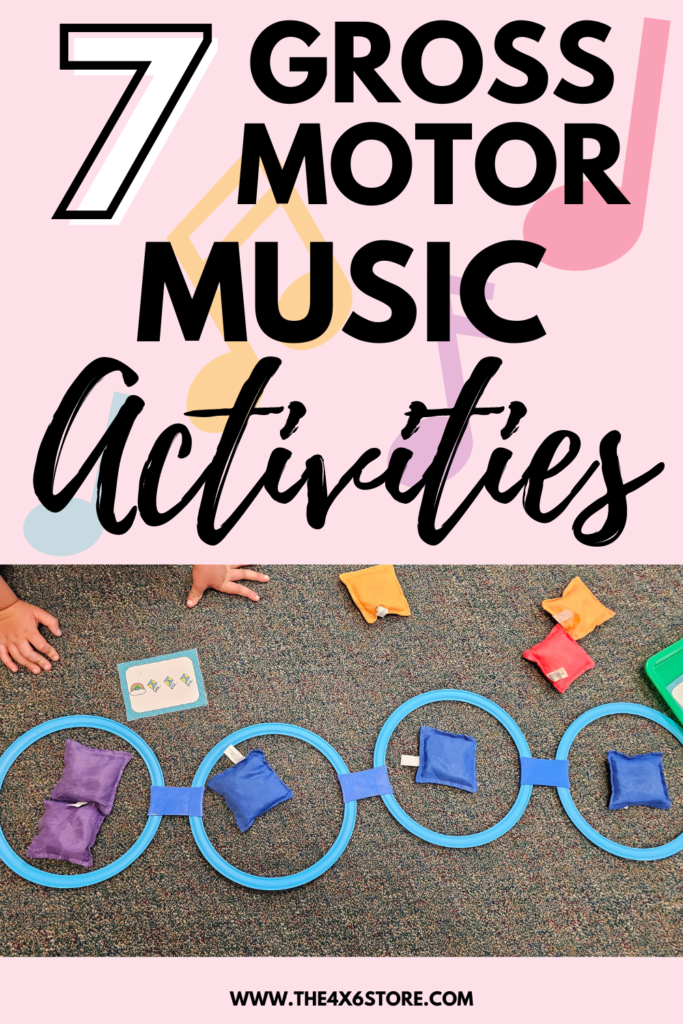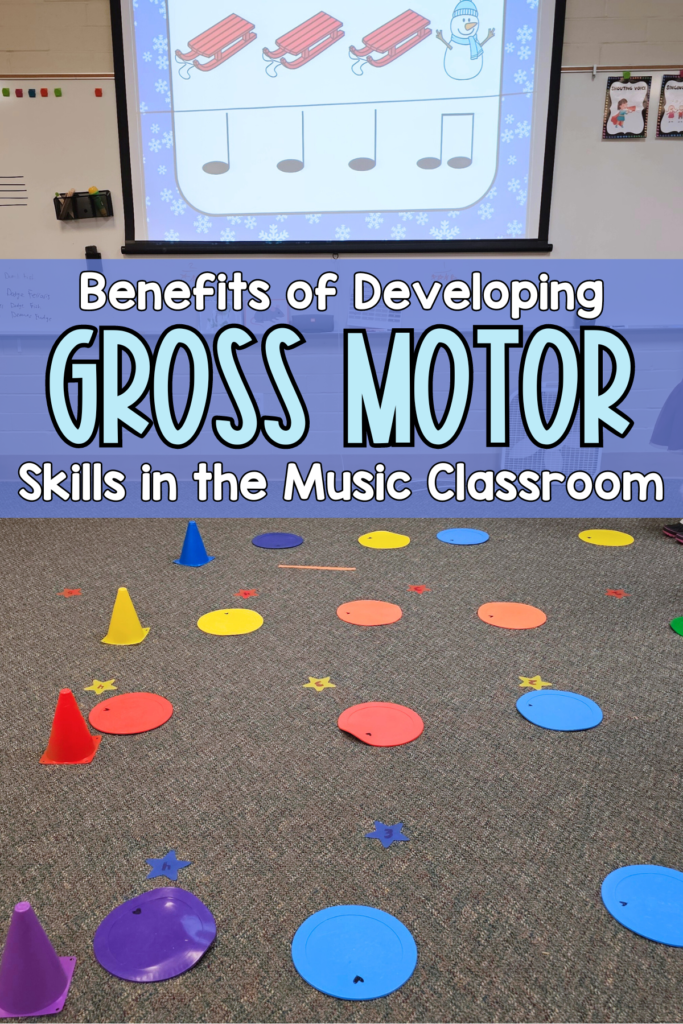Crossing the Midline in Early Elementary Music
In elementary music classes, students don’t just learn to sing or play instruments—they also engage in activities that support essential developmental skills. One of those important skills that incorporates gross and fine motor skill development is crossing the midline. This seemingly simple motion has profound benefits for children’s growth, from improving coordination to strengthening neural connections.
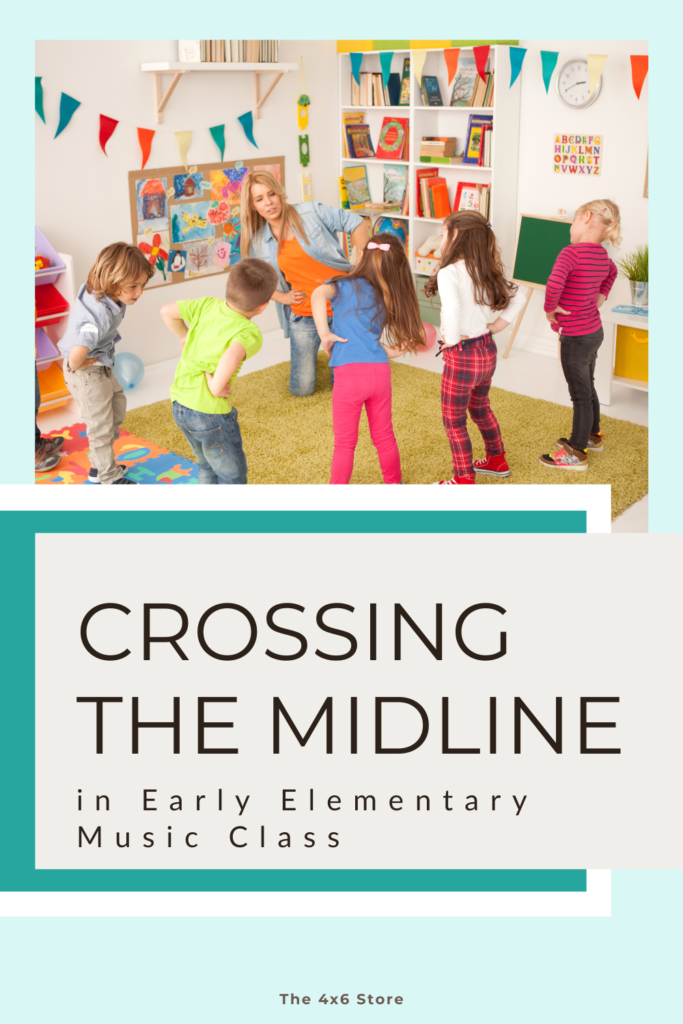
In this blog post, we will explore the benefits of crossing the midline and share specific music activities that integrate play-based learning and this important skill. Whether you’re an elementary music teacher looking to enhance your curriculum or a parent seeking activities to support your child’s growth, these crossing the midline music activities will keep kids engaged and improving on their developmental journey.
Table of Contents
Benefits of Crossing the Midline
- Increased Neural Connections
- Improved Coordination
- Enhanced Cognitive Abilities
- Develop Reading and Writing Skills
Crossing the Midline Music Activities
- Ribbon and Scarf Dancing
- Steady Beat Sabers
- Cross-body Body Percussion
- Clapping Games
- Guided Instrument Playing
- Songs with Movements
- Passing and Catching Activities
This post contains affiliate links. As an Amazon Associate, I earn from qualifying purchases at no extra cost to you! All affiliate links in this post will be marked with an *. My participation in the Amazon Associate program helps keep other “annoying” advertisements off my website. – Thanks
Benefits of Crossing the Midline
Crossing the midline refers to the ability to move a limb or part of the body across the centerline (midline) that divides the body into left and right halves. For example, reaching with your right hand to an area on the left side of your body is crossing the midline.
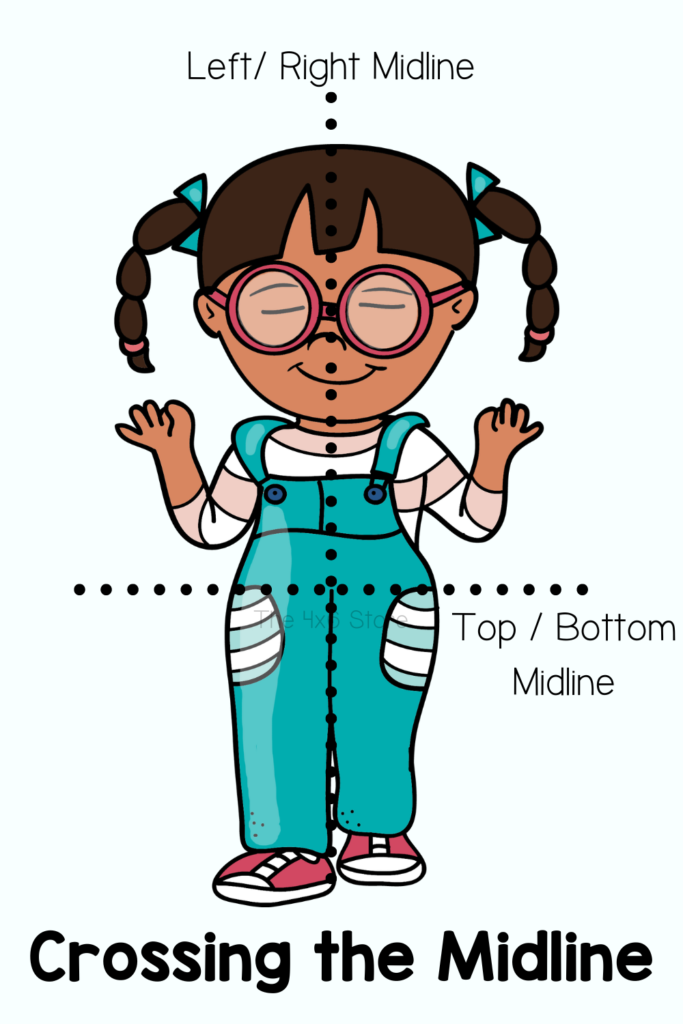
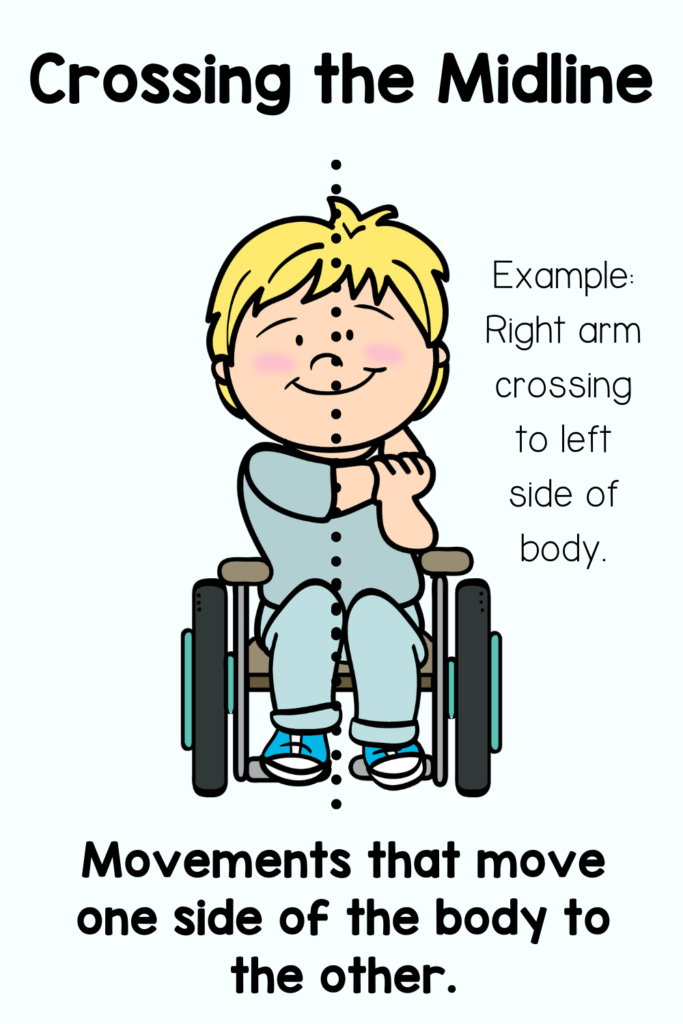
There are many reasons that activities that cross the midline are important for a child’s development – both physically and mentally. While other subjects and classes may address crossing the midline, music is an excellent class for students to ENJOY crossing the midline activities! Below are some of the reasons our students should be participating in cross-body activities in music.
Increased Neural Connections
Your youngest students have 100 BILLION brain cells that they are actively trying to connect and understand as they actively experience the world. (No wonder they are so busy!) During the first few years of life, new neural connections are being made at a rate of a million or more connections per second! That’s a lot of brain power!
Research has shown that crossing the midline helps with these connections leading to…
Improved Coordination
We also know that the right hemisphere of the brain controls the left side of the body and visa versa. Activities that cross the midline help form neural connections between hemispheres. These connections refine gross motor and fine motor skills! < If you haven’t already, check out why these are important, too!
When our students were younger, their medical providers closely watched their developmental milestones. Simple tasks such as transferring objects from one hand to the other (across the midline) is the beginning of a long series of coordination milestones.
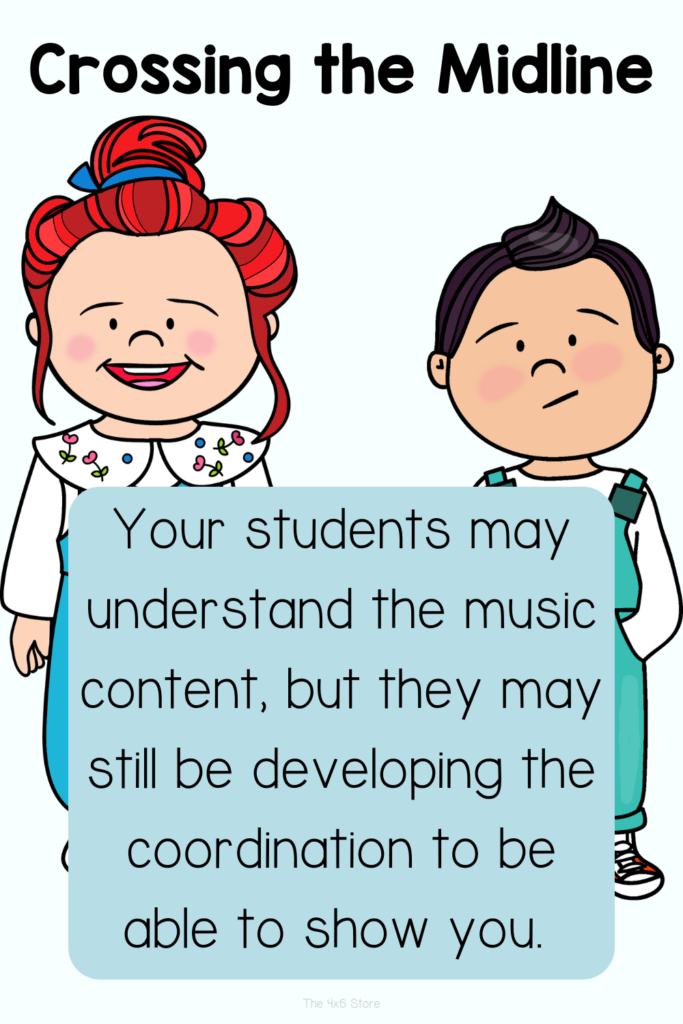
Once our musicians hit kindergarten, most of them have mastered their midline crossing milestones – but not all of them. Tasks that require good eye hand coordination, such as cutting with scissors or writing precision, are still being developed. You may notice some of your students color the right side of a page with their right hand and the left side of the page with their left. Or some may struggle to keep up with the beat in whole body movements that require crossing the midline. It may be that your student understands your music content but is still developing their coordination to be able to show you.
Enhanced Cognitive Abilities
As students build their neural networks, it increases the capacity for more cognitive intense activities.
Music education is the beautiful mixture of math, reading, science, and history. Participating in activities that cross the midline prepares our students to dive into the more thinking intensive parts of music. These activities include recognizing musical patterns, understanding the relationship between rhythm and beat, reading notation, playing instruments, and so on.
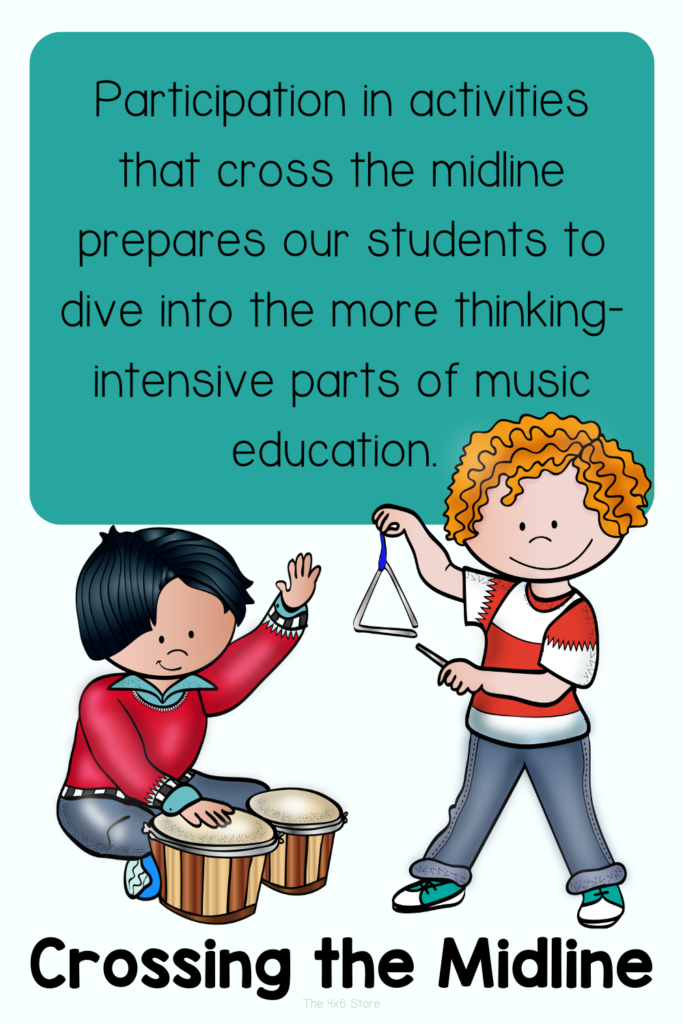
Develop Reading and Writing Skills
Part of the cognitive growth is found in the development of reading and writing skills. Reading and writing are important skills in the music classroom, to! Musical notation is basically a new language system that we teach them to read and write. Without the development of foundational gross and fine motor skills, reading and writing may become a barrier for the advancement or confidence of some our musicians. Even older students may show the need for midline crossing activities, too!
Implementing activities that cross the midline with our preschool and kindergarten students will have a lot of benefit for years to come!
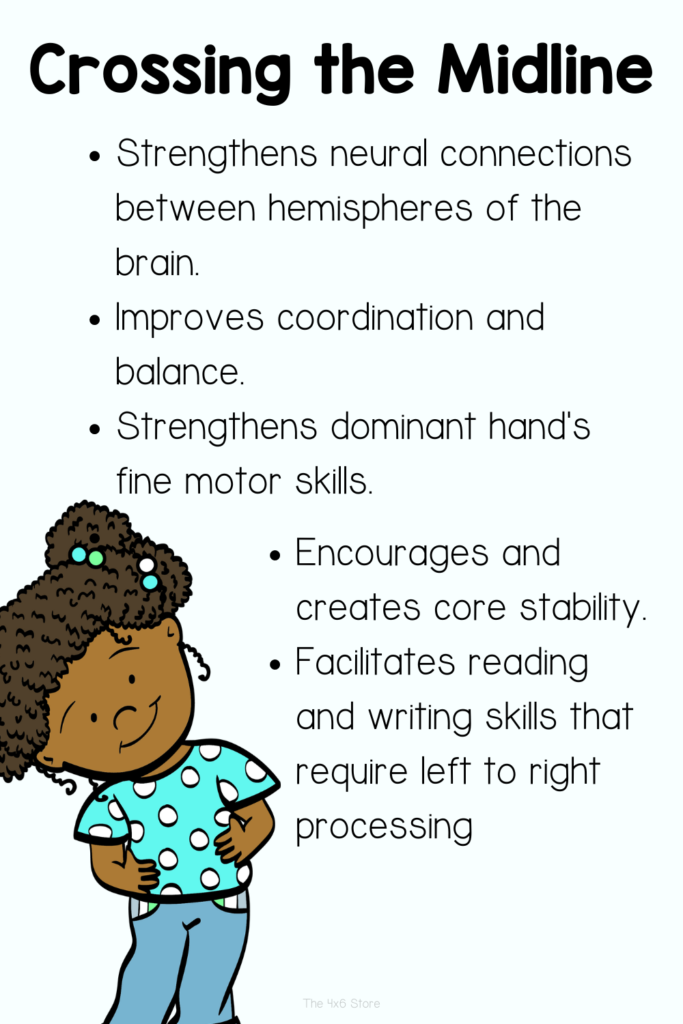
Crossing the Midline Music Activities
Incorporating movement into music lessons is an effective way to support crossing the midline and promote motor skill development. The following activities not only engage students physically to the concepts being taught, but also enhance their coordination, cognitive abilities, and overall musical understanding. From ribbon dancing to clapping games and instrument play, these exercises offer creative, fun ways for children to develop both musically and physically.
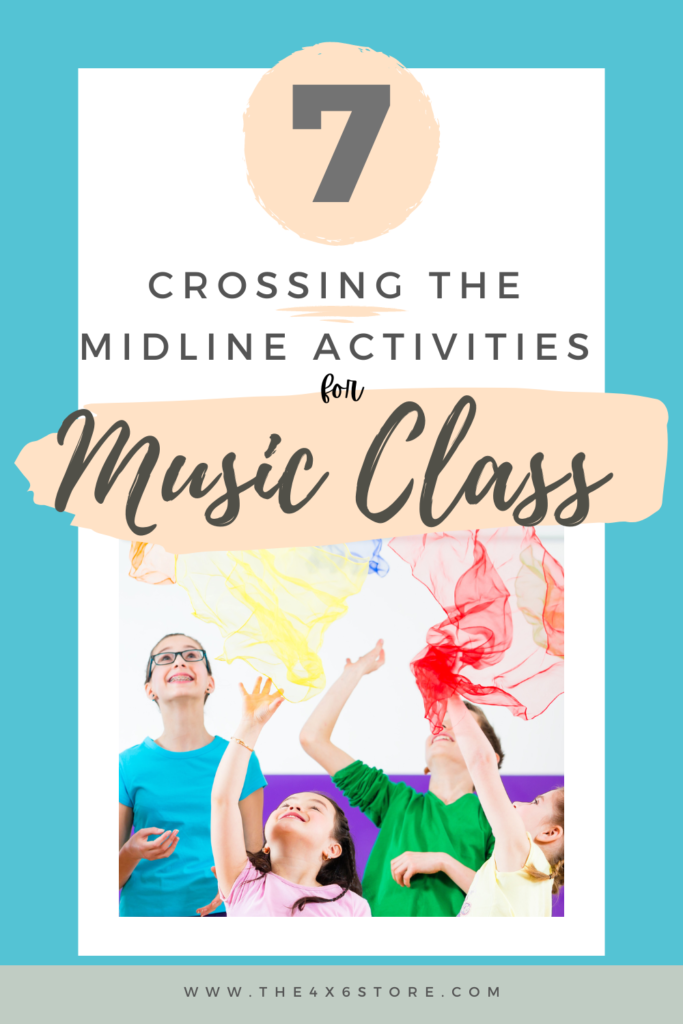
Ribbon and Scarf Dancing
Using ribbons or scarfs to create movements that cross the midline are among the easiest to do. Simply pull them out, turn on some music, and guide your students through various motions that cross the midline. The movements do not have to be fancy or technical. Creating rainbow shapes that begin on one side and end on the other is a great place to begin. Reviewing shapes by making large air-drawn masterpieces is also a great way to cross the midline with ribbons or scarves.
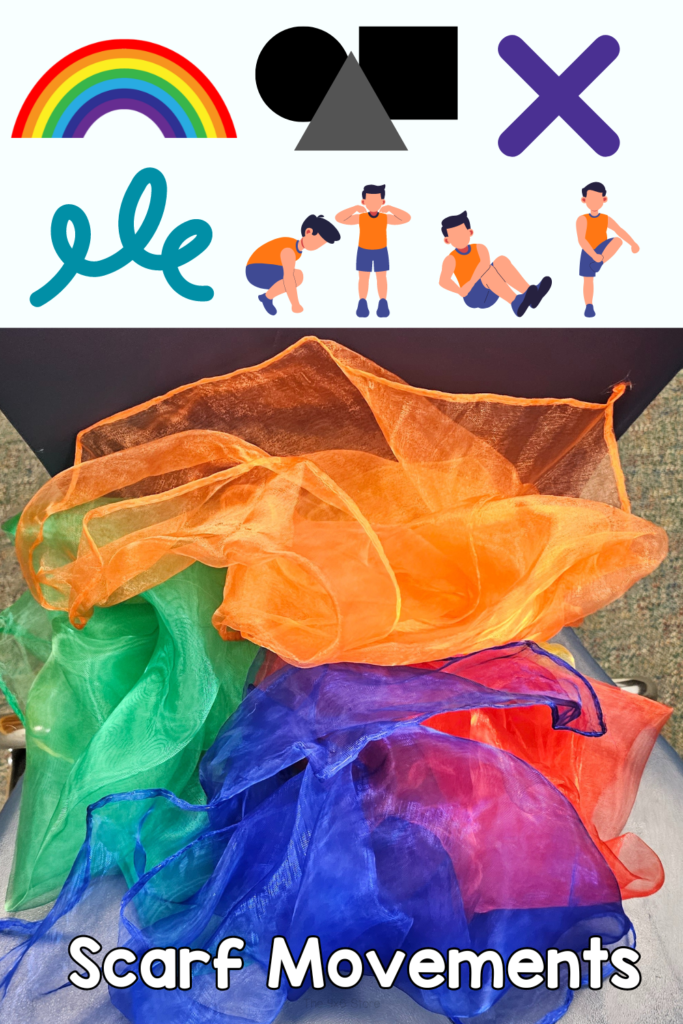
More complicated activities can involve crossing the up/down midline! Students can reach down and touch their opposite toes or bring their feet up from the floor. Another core building exercise is to sit on the floor and move the scarves from one side or their body to the other side with a small twisting motion.

Steady Beat Sabers
I created these DIY pool noodle Steady Beat Sabers. I love to use these to cross the midline. Before students are allowed to practice with a friend, they spend time copying my movements. I begin with simple up and down movements to the beat before moving on to horizontal, side-to-side movements and then large vertical “X”s. After practicing those skills, we move on to a controlled tap
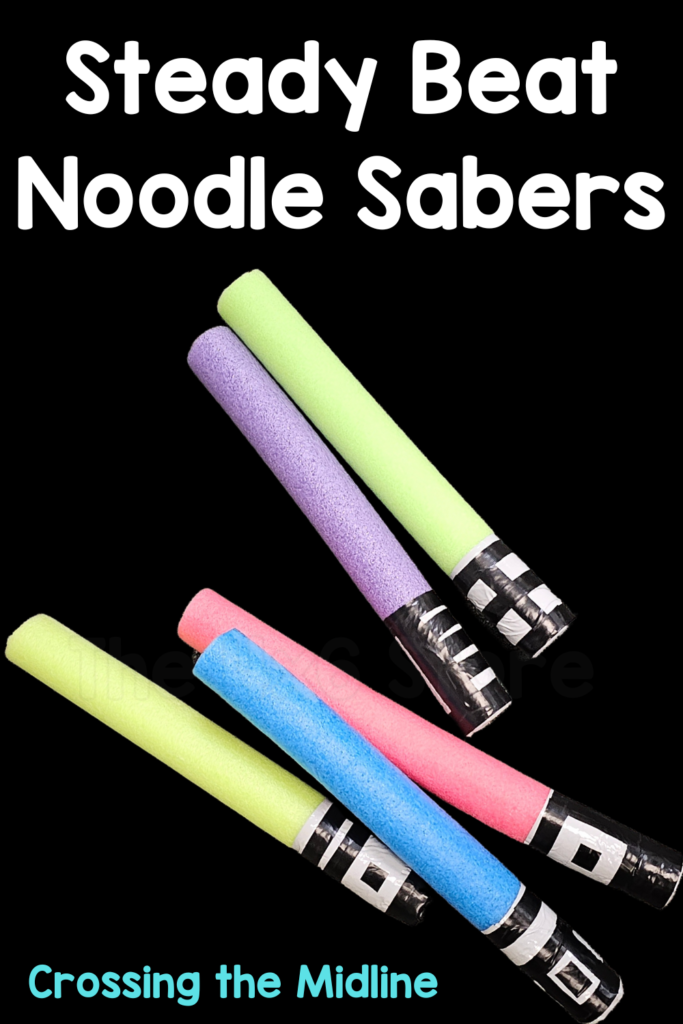
Cross-Body Body Percussion
Body Percussion is a great way to easily add crossing the midline to what you already do! Instead of just clapping, clap in a large box or from one side of the body to the other. When patting your knees, pat the opposite knee! (Or shoulders, or hips…) You can find many body percussion videos on YouTube or make it up on the spot to your students’ favorite songs!
Clapping Games
Think back to your childhood days. For many of us it included clapping games like Miss Mary Mack, See, See, My Playmate, and Down by the Banks of the Hanky Panky. (Or my mother’s least favorite, Miss Suzie had a steamboat…. We won’t be teaching that one any time soon!)
Almost all of these games have midline crossing elements and can be adapted or taught to the appropriate age groups. My own children have greatly enjoyed Sevens. *There are many versions of this on YouTube. I would suggest finding the one that works the best for you and your students. But it is a HIT and well loved!
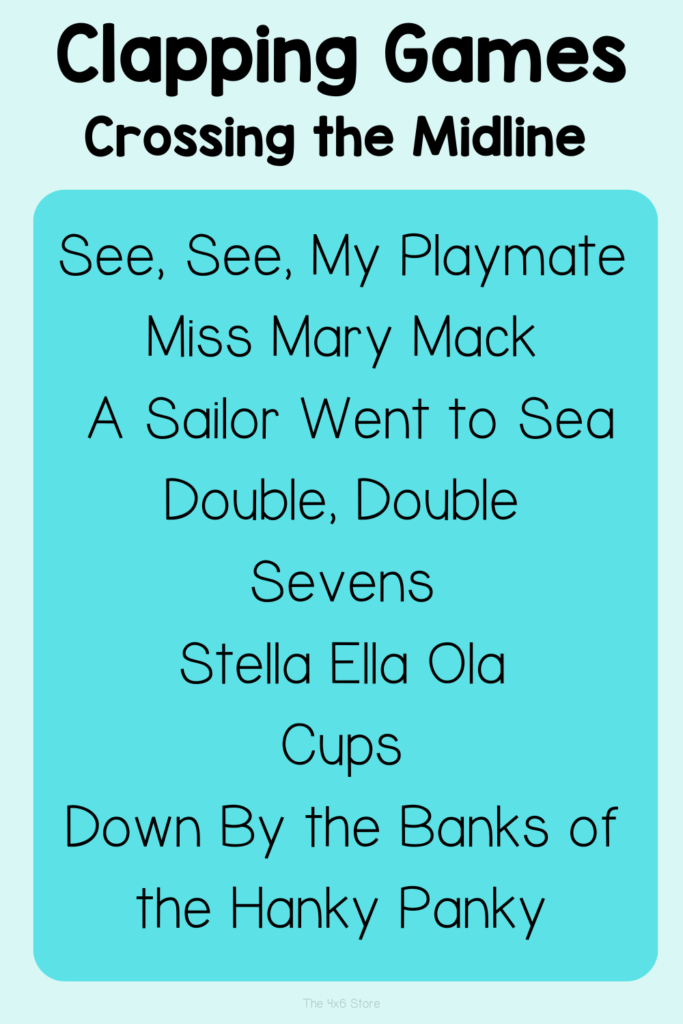
The best part of clapping games?! Zero materials required!
Personal anecdote: I would love to see an epic come back of kids spending time playing clapping games over doom scrolling on TikTok.
Guided Instrument Playing
Young students who have not mastered crossing the midline will often NOT cross the midline unless prompted. Using instruments (with the teacher guiding hand position) can add extra incentive to practice midline crossing. Some examples of ways you can use instruments for this skill include:
Drum patters – On a larger drum or bongos, have students copy different drumming patterns that require hands to cross to the opposite drum or side of the drumhead. This may be as simple as a steady beat with the cross body hand positioning.
Shakers or maracas – Using an easily held shaking instrument, students can practice playing in the space all around their body. Besides copying the teacher, students can come up with their own places to shake!

Xylophones or barred instruments – Instead of focusing on creating certain tones or melodies, students can practice playing the lower notes with their right hand and the higher notes with their left.
Cymbals – Provided you have a set of cymbals appropriately sized for your learners, this can be a multisensory approach! The vibrations from the cymbals will give extra sensory input to this midline activity. One suggestion is to have the students hold one cymbal stationary in one hand and move the other hand in for the CRASH! You can incrementally move their arm further away from the midline for a larger cross.
Songs with Crossing the Midline Movement
Many early childhood songs are already integrated with crossing the midline actions. Think about The Wheels on the Bus. The rolling, swishing horn honking… many of them cross the midline! Other classics include hand jiving with Hey, Mr. Knickerbocker, swishing and swimming while Going on a Bear Hunt, and enjoying shaking it during the Hokey Pokey. Even the endless replays of Baby Shark has crossing the midline actions!
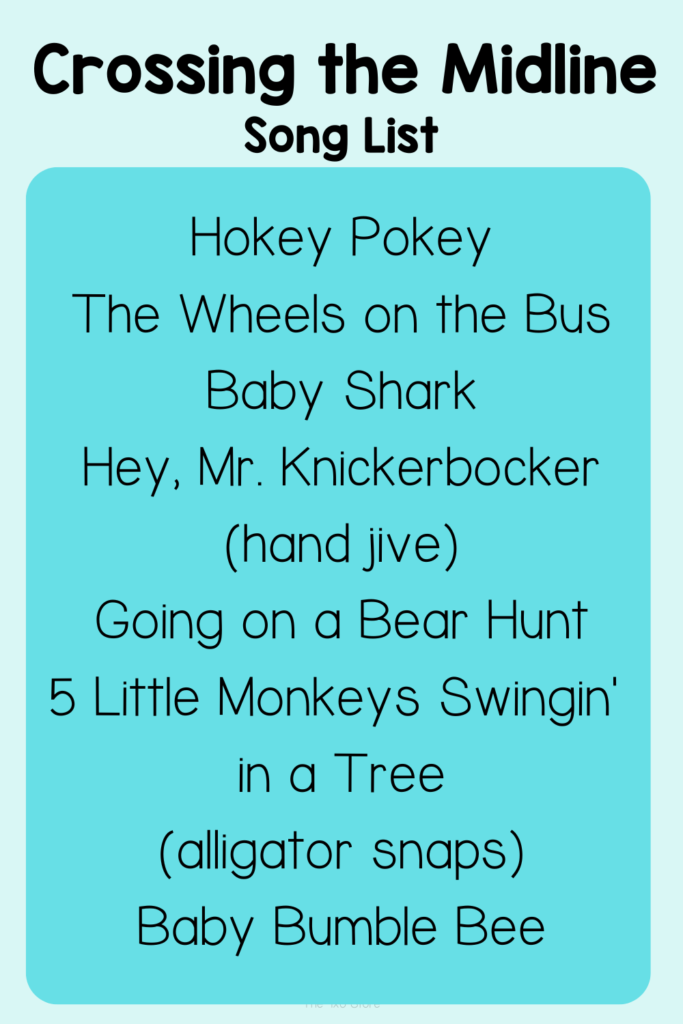
This YouTube playlist is not mine – but it has some good ones!
Passing and Catching Activities
Passing games are a great midline crossing activity. Students are typically sitting for passing games, but the “take and pass” motion moves the arms across the midline. This can also be as simple as picking an upbeat song or song from your current lessons that you adapt into a passing game.
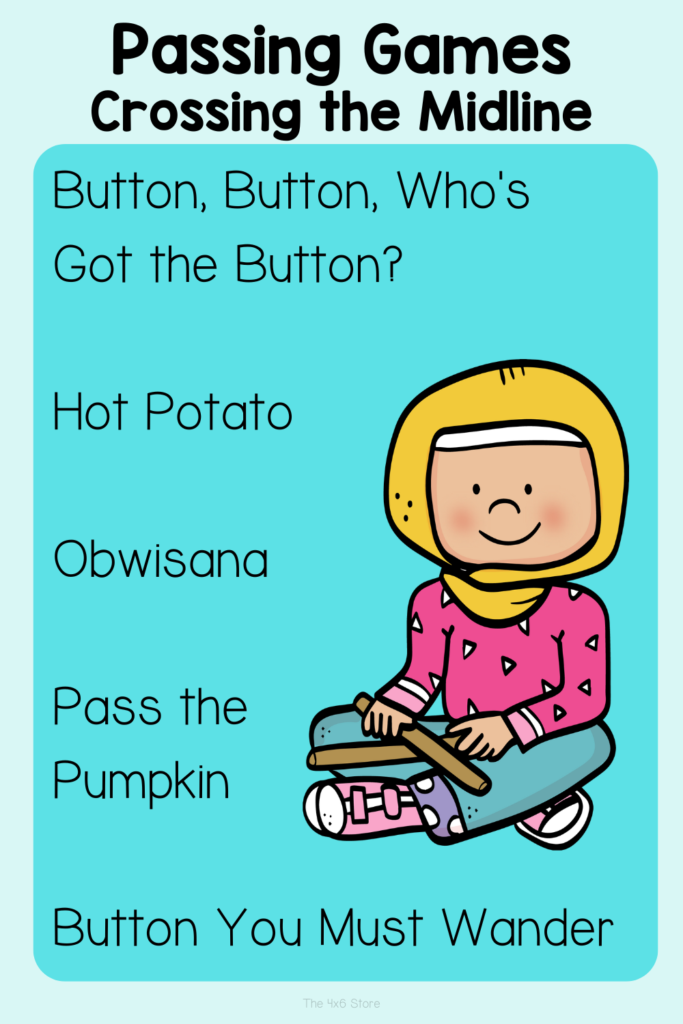
Tossing and catching games are more advanced midline activity. It requires students have more developed eye hand coordination and gross motor skill development. You can use many different objects to change up the feel or difficulty of the activity including bean bags, different sized balls, or stuffed animals.
Activities with a bean bag or small ball can be structured by using songs like “Plainsies Clapsies.” (Find the music and actions here – thanks to Beth’s Music Room.) Or they can be improvised while playing upbeat music. Tossing the objects between partners (hopefully to a steady beat) also encourages crossing the midline as they move their bodies to catch. For an added midline challenge, have students pass on a diagonal instead of straight across.
Conclusion
You are likely already do many of these crossing the midline activities in your music classroom already. Incorporating activities involving crossing the midline will help your students in their developmental and musical growth! As you intentionally practice this skill with your musicians, you are helping them to become more capable of more challenging musical tasks down the road!
More on Motor Skills
Sources & Acknowledgements:
Clipart by: Artifex
https://www.medicalnewstoday.com/articles/321037
